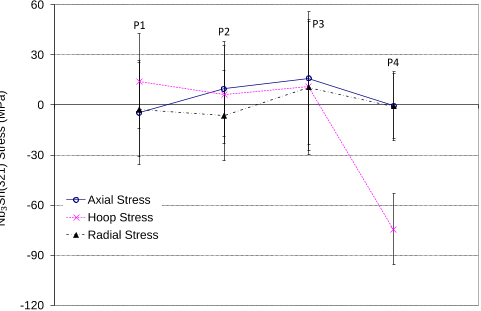




read more











When the externally applied load to the coil exceeds a critical value, crack formation in the Nb3Sn filaments causes an irreversible Jc degradation [6].
During magnet operation this conductor block at the coil midplane is subjected to the highest stress levels, and the neutron diffraction results suggest that this causes a significant residual Nb3Sn stress that remains after magnet disassembly and removal of the collars.
The Nb3Sn strain state in a magnet coil may be influenced by mechanical material properties of theconductor constituents, by friction coefficients between different materials pairs, by cabling, coil winding and Nb3Sn reaction processes, by the collaring and magnet assembly at ambient temperature and finally by thermal and powering cycles of the magnets during operation.
The superconducting properties of Nb3Sn are strain sensitive, and the reversible strain dependence of the critical current density (Jc) is commonly ascribed to elastic Nb3Sn lattice distortions [3,4,5].
The two-dimensional diffraction patterns were caked in 36 circular sectors, each one of them being radially integrated in order to measure lattice parameters from the crystalline planes oriented both in the radial and the hoop direction.
The penetration depth of high energy photons in the highly absorbing metallic Nb3Snsuperconductors is limited to a few millimeters.
In the d-spacing range that was acquired by neutron diffraction four peaks can be identified by comparison with the reference patterns, notably Cu (220), Nb3Sn (400), Nb (211) and Nb3Sn (321).
In order to get sufficiently accurate absolute strain results, diffraction scans across the same sample were always acquired two times, at Ω = 0 º and at Ω = 180º.
Beyond the measurement of the Nb3Sn residual strain homogeneity in coils after the reaction heattreatment, residual strain and stress measurements as they are now possible with neutron strain scanners like Stress-Spec open the way for experiments where mechanical stress is applied for instance through steel collars as they are used in the 11 T dipole magnets.
Neutron diffraction measurements have also been applied to study the strain state in Nb3Sn wires [11], and they are particularly well suited to study samples with relatively large sample volume, like the ITER Nb3Sn central solenoid cable [12].
Because of the comparatively deep penetration of the neutron beam, diffraction measurements could be performed in the center of a massive 4 cm-thick 11 T coil #107 segment, and the Nb3Sn lattice parameter was measured in the center of the four largest conductor blocks in axial, radial and hoop directions (Figure 2).
For the residual stress calculations the hkl elastic constants need to be known, and the Nb3Sn texturing needs to be considered as well [29].
For the determination of the residual strain by XRD in the center of the different conductor blocksa 10 pixel × 10 pixel box filter was applied to average the d-spacing values in an area of 5 × 5mm2.
In the present case the maximum sampling depth is about 2 cm, mainly limited by the relatively strong neutron absorption in the epoxy impregnation of the coil.
This suggeststhat Cu in the extracted wire might be under slight axial tension (0.005%) and Nb3Sn under slight axial precompression (0.003%).